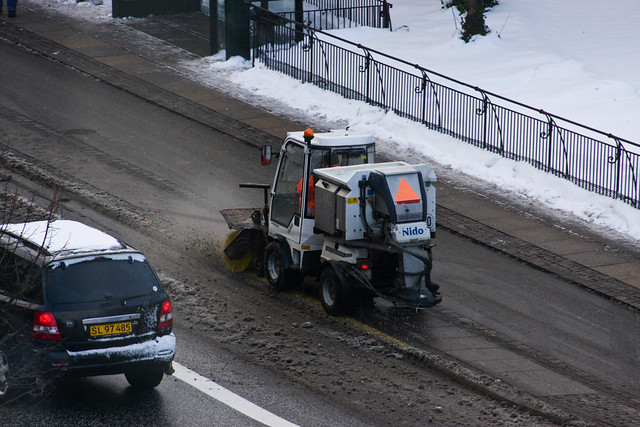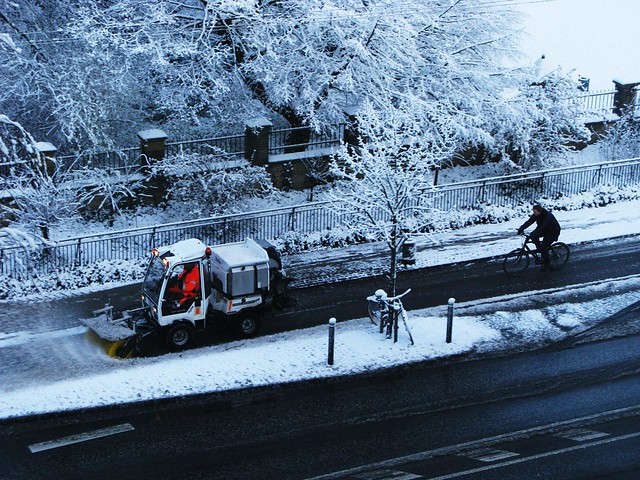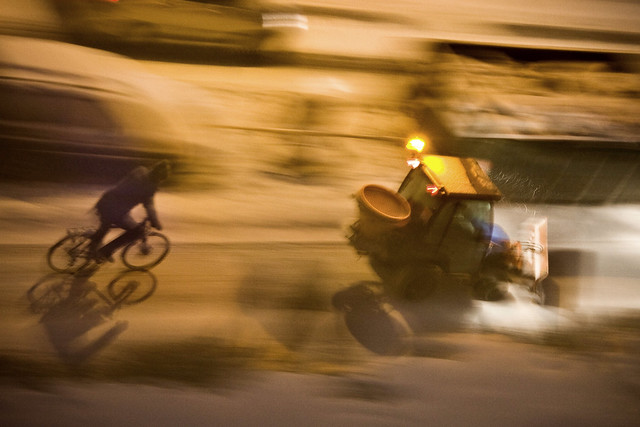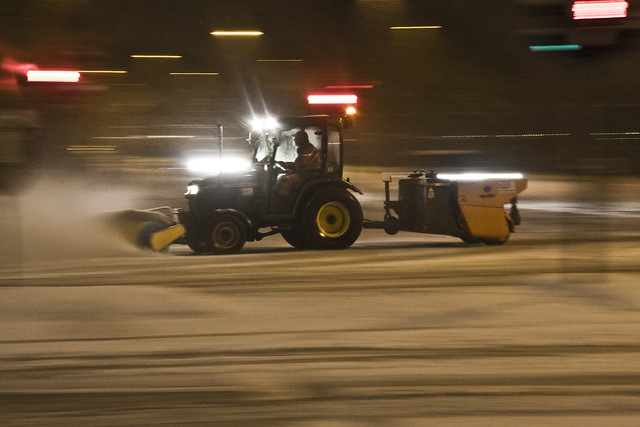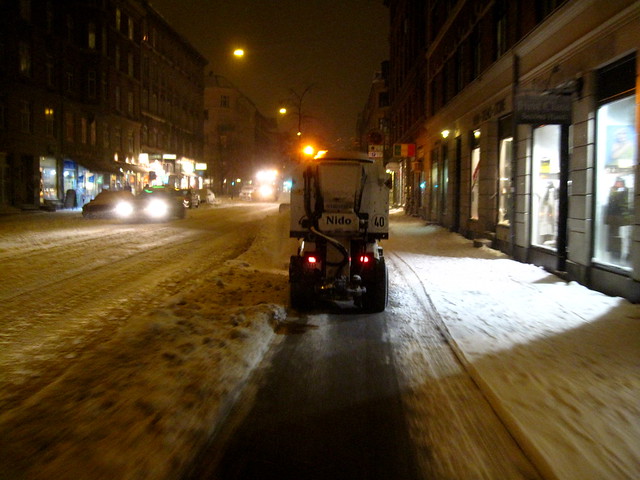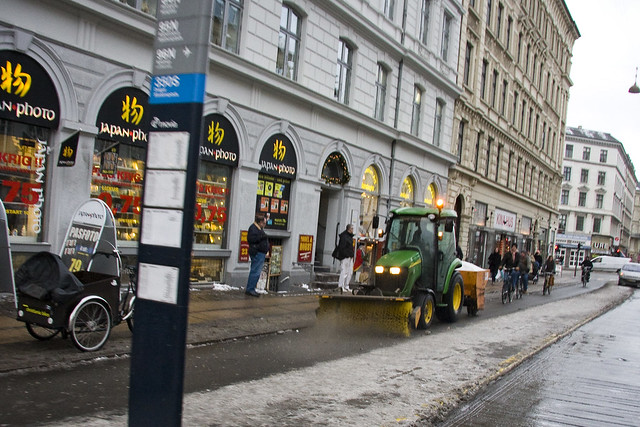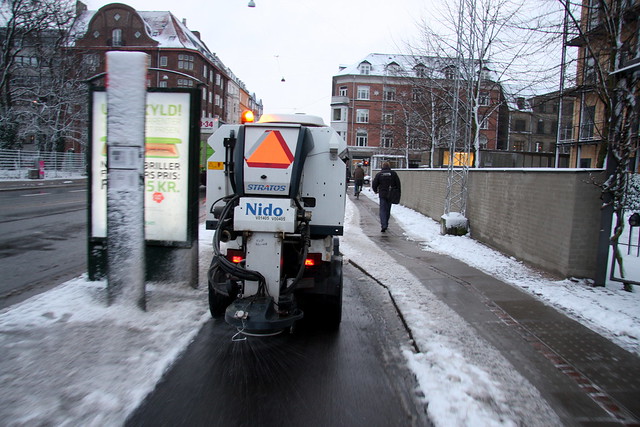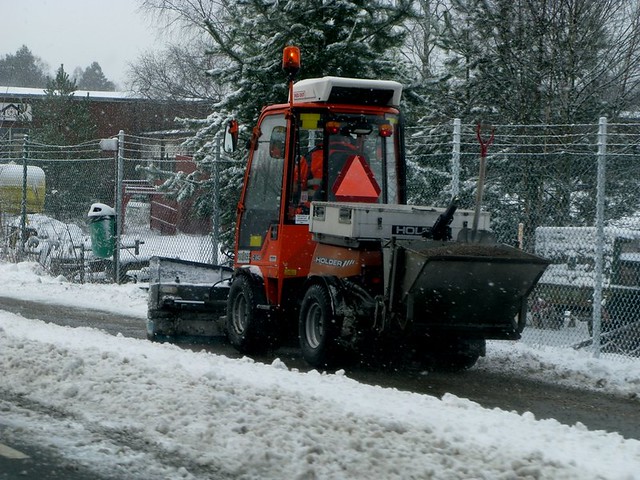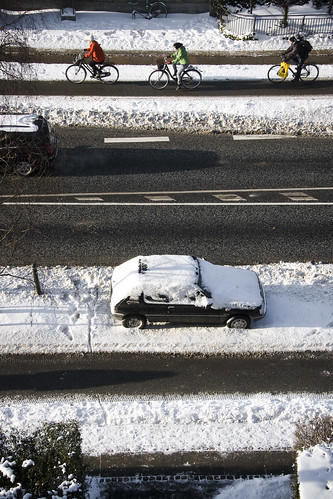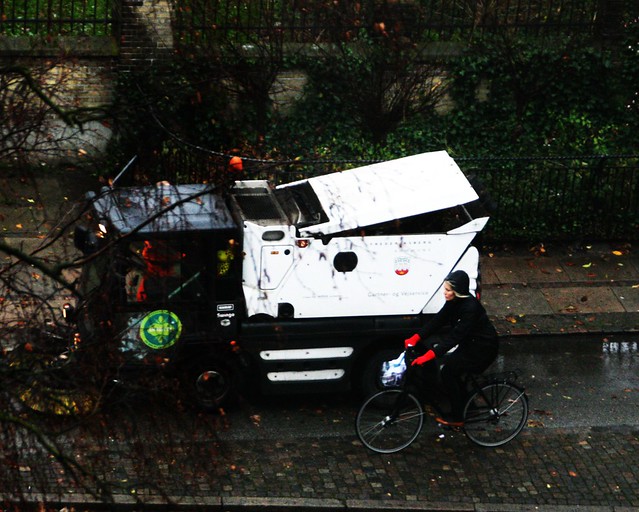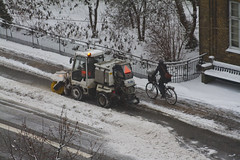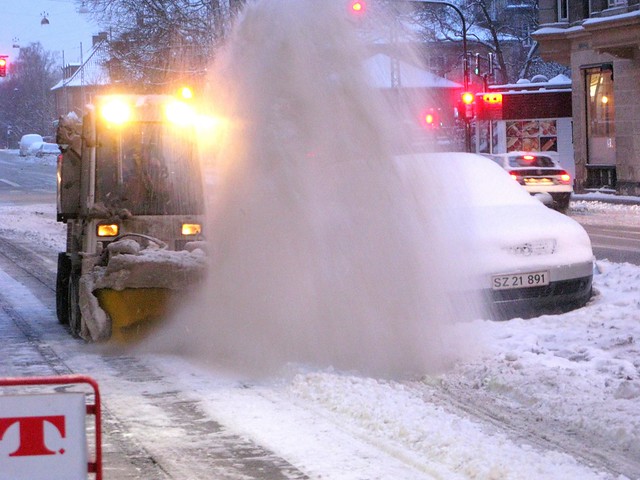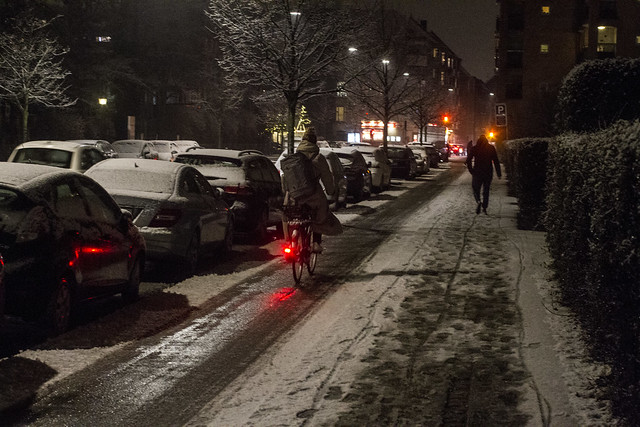
ADDENDUM: 18 Dec 2010. I made this little film and blogged about it. Adding it, rightly so, this post.
I spotted one of our lovely street sweepers/snow removers at work the other day. It really is the loveliest sound on the streets during winter. We've had about 45 cm of snow at time of writing but these working class heroes keep the bike lanes clear. The cities of Copenhagen and Frederiksberg salt before snow falls and, after the snow is on the ground, the bike lanes are cleared before the streets. During snowstorms I've seen these bike lane sweepers roll back and forth past my flat six times before any snowploughs cleared the street. I live on a busy crosstown artery. In the above photo it's a bus stop island getting an extra sweep. That's the bike lane to the right of the sweeper. (As an aside, we have many of these bus stop islands in Copenhagen. If there is one present, disembarking passengers have to wait before crossing to the sidewalk. Bicycles have the right of way. If there is no island, bicycles have to stop for passengers.) Then the sweeper came back on the other side of the street. Shoving the snow onto the street - and covering parked cars. The sidewalk and the bike lane are clear of snow.
 Here is an indication about how seriously Copenhagen takes prioritizing snow clearance for cyclists. On the left is a map of all the on-street bicycle infrastructure. On the right is a map of the bicycle infrastructure that is cleared of snow before the roads are even considered. You have to be able to count on the bicycle infrastructure, like you would a train timetable.
I've blogged many of these snow clearance photos before, but here they all are in one place. The bike lane sweepers, because they run constantly during snowy weather, are only equipped with a heavy-duty brush. Snow is rarely left for long so a snowplough attachment isn't necessary. You often see people riding Keirin-like behind them.
Another Keirin ride. This was taken during a heavy snowstorm. When such weather is upon us, many other sweepers and - in the case of the photo above - snowploughs proper are enlisted to keep the bicycle infrastructure clear.
Like this one. Not a regular feature in Copenhagen, this tractor was drafted into action during a storm last year. Brush at the front and salt spreader at the back. This was taken at 22:15 one Saturday evening. If there is snow falling, it's getting cleared. At all hours. It is a many decades old arrangement that farmers in the surrounding area to Copenhagen are enlisted to help the city with snow clearance during snowstorms.
I rode behind this one during a storm last year. But he was a bit slow, so I ended up overtaking him, leaving him to eat my flakes. With the early snow this year there are, however, some issues with budgets for snow clearance all over Denmark. Last year was a nasty winter with regular snowstorms and many municipalities spent more than they snow clearance budget. Many have saved up in case this winter was the same and so far it is - it's started much earlier, though, so budget grumbling is heard across the land.
Here's another sweeper and salt spreader. No new snow on the infrastructure, but it was forecast, so they do an extra run to clear it and spread salt. Yes, salt is a pain in the ass. There has been talk of gravel but the Copenhagen sewers, they say, wouldn't be able to handle it. Not surprisingly, there is a lot of research going on into a replacement for salt. Last winter a number of municipalities ran out of salt. A ship sailed from Sicily with salt for many Danish cities. Even the City of Copenhagen was running very low. So low that they issued a statement saying that the last salt reserves would only be used on the bicycle lanes and not the streets. Nice.
Another sweeper and salt spreader. Personally, as a bicycle user, I take the salt with... a grain of salt. It's a pain in the ass but if it helps me and the rest of the bicycle traffic rolling on cleared bicycle infrastructure, then I'll take it.
It's not just Copenhagen. This is a sweeper and, in this case, gravel spreader in the small town of Höör, Sweden. Population about 7,000. Keeping the bike infrastructure clear for the citizens.
The result? Clear channels on which the bicycle traffic can move. Prioritizing the bike lanes is, of course, a great and necessary way to encourage people to ride bicycles all through the year. On the other hand, it is also a practical necessity. If the bicycle lanes weren't cleared, a whole lot of people on the day after a snowstorm wouldn't ride. Tens of thousands. They would seek alternatives. Cars, perhaps, but mostly public transport. Imagine the complications of having tens of thousands of people suddenly show up at train stations and bus stops. A logistical nightmare. So keeping the bike lanes clear is an important factor in keeping Copenhagen moving. (As an aside, note the plastic protectors in front of the trees. This is common all over Copenhagen in the winter. Protecting the trees from salt and grime and slush. Sometimes they're plastic, sometimes wicker fences.)
Here's a good result photo after a spot of snowfall last year. Sidewalk (at bottom) is cleared somewhat. Not entirely, but enough, by the super in our building. The bike lane is cleared to perfection. The streets have been ploughed. Repeat on the far side. Copenhagen is kept moving. When the going really gets tough, The Slow Slinger is called in. Once the snow drifts get too big from all that pushing snow out of the way, this machine eats them up for breakfast, spitting the snow into dumptrucks.
The groovy snow sweepers serve other functions all through the year. They're designed for use on the bicycle infrastructure. Here is a shot of one sweeping up leaves in the autumn. ADDENDUM: More shots
Watch out where you park your car! The bicycles rule.
ADDENDUM: 10 JANUARY 2016 Just spotted this. It's 19:00 on a Sunday night at the sweeper/salters are in action as soon as the snow starts falling.
Clearing snow and salting, prepping for the rush hour in the morning....
But also for the people cycling for transport now.
Here is an indication about how seriously Copenhagen takes prioritizing snow clearance for cyclists. On the left is a map of all the on-street bicycle infrastructure. On the right is a map of the bicycle infrastructure that is cleared of snow before the roads are even considered. You have to be able to count on the bicycle infrastructure, like you would a train timetable.
I've blogged many of these snow clearance photos before, but here they all are in one place. The bike lane sweepers, because they run constantly during snowy weather, are only equipped with a heavy-duty brush. Snow is rarely left for long so a snowplough attachment isn't necessary. You often see people riding Keirin-like behind them.
Another Keirin ride. This was taken during a heavy snowstorm. When such weather is upon us, many other sweepers and - in the case of the photo above - snowploughs proper are enlisted to keep the bicycle infrastructure clear.
Like this one. Not a regular feature in Copenhagen, this tractor was drafted into action during a storm last year. Brush at the front and salt spreader at the back. This was taken at 22:15 one Saturday evening. If there is snow falling, it's getting cleared. At all hours. It is a many decades old arrangement that farmers in the surrounding area to Copenhagen are enlisted to help the city with snow clearance during snowstorms.
I rode behind this one during a storm last year. But he was a bit slow, so I ended up overtaking him, leaving him to eat my flakes. With the early snow this year there are, however, some issues with budgets for snow clearance all over Denmark. Last year was a nasty winter with regular snowstorms and many municipalities spent more than they snow clearance budget. Many have saved up in case this winter was the same and so far it is - it's started much earlier, though, so budget grumbling is heard across the land.
Here's another sweeper and salt spreader. No new snow on the infrastructure, but it was forecast, so they do an extra run to clear it and spread salt. Yes, salt is a pain in the ass. There has been talk of gravel but the Copenhagen sewers, they say, wouldn't be able to handle it. Not surprisingly, there is a lot of research going on into a replacement for salt. Last winter a number of municipalities ran out of salt. A ship sailed from Sicily with salt for many Danish cities. Even the City of Copenhagen was running very low. So low that they issued a statement saying that the last salt reserves would only be used on the bicycle lanes and not the streets. Nice.
Another sweeper and salt spreader. Personally, as a bicycle user, I take the salt with... a grain of salt. It's a pain in the ass but if it helps me and the rest of the bicycle traffic rolling on cleared bicycle infrastructure, then I'll take it.
It's not just Copenhagen. This is a sweeper and, in this case, gravel spreader in the small town of Höör, Sweden. Population about 7,000. Keeping the bike infrastructure clear for the citizens.
The result? Clear channels on which the bicycle traffic can move. Prioritizing the bike lanes is, of course, a great and necessary way to encourage people to ride bicycles all through the year. On the other hand, it is also a practical necessity. If the bicycle lanes weren't cleared, a whole lot of people on the day after a snowstorm wouldn't ride. Tens of thousands. They would seek alternatives. Cars, perhaps, but mostly public transport. Imagine the complications of having tens of thousands of people suddenly show up at train stations and bus stops. A logistical nightmare. So keeping the bike lanes clear is an important factor in keeping Copenhagen moving. (As an aside, note the plastic protectors in front of the trees. This is common all over Copenhagen in the winter. Protecting the trees from salt and grime and slush. Sometimes they're plastic, sometimes wicker fences.)
Here's a good result photo after a spot of snowfall last year. Sidewalk (at bottom) is cleared somewhat. Not entirely, but enough, by the super in our building. The bike lane is cleared to perfection. The streets have been ploughed. Repeat on the far side. Copenhagen is kept moving. When the going really gets tough, The Slow Slinger is called in. Once the snow drifts get too big from all that pushing snow out of the way, this machine eats them up for breakfast, spitting the snow into dumptrucks.
The groovy snow sweepers serve other functions all through the year. They're designed for use on the bicycle infrastructure. Here is a shot of one sweeping up leaves in the autumn. ADDENDUM: More shots
Watch out where you park your car! The bicycles rule.
ADDENDUM: 10 JANUARY 2016 Just spotted this. It's 19:00 on a Sunday night at the sweeper/salters are in action as soon as the snow starts falling.
Clearing snow and salting, prepping for the rush hour in the morning....
But also for the people cycling for transport now.
